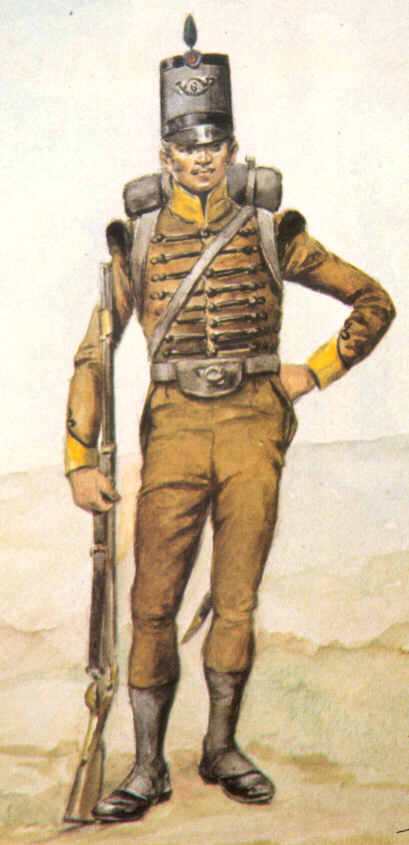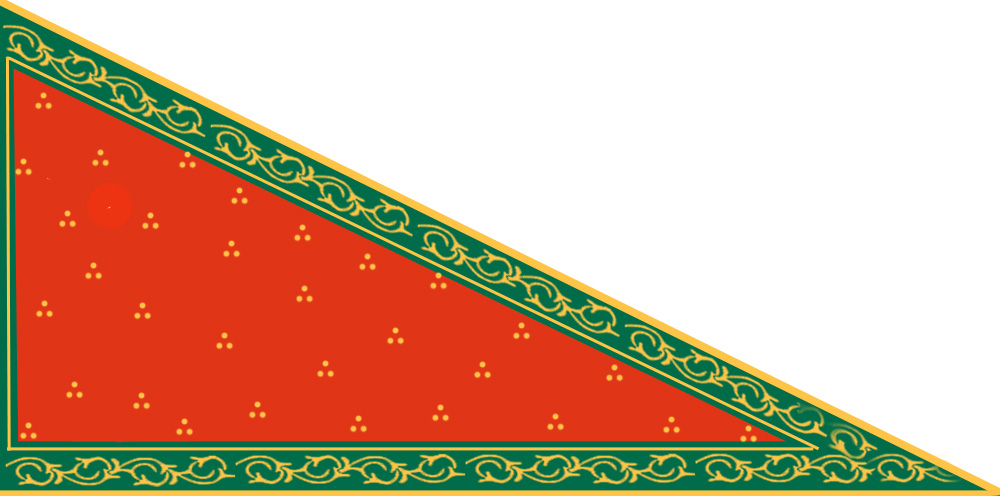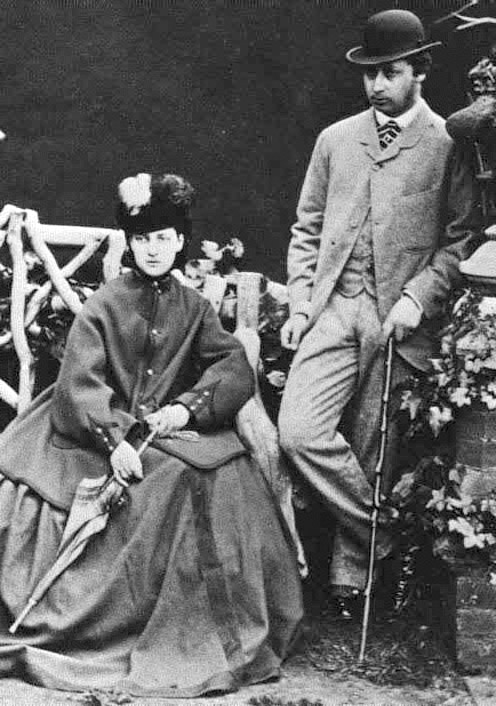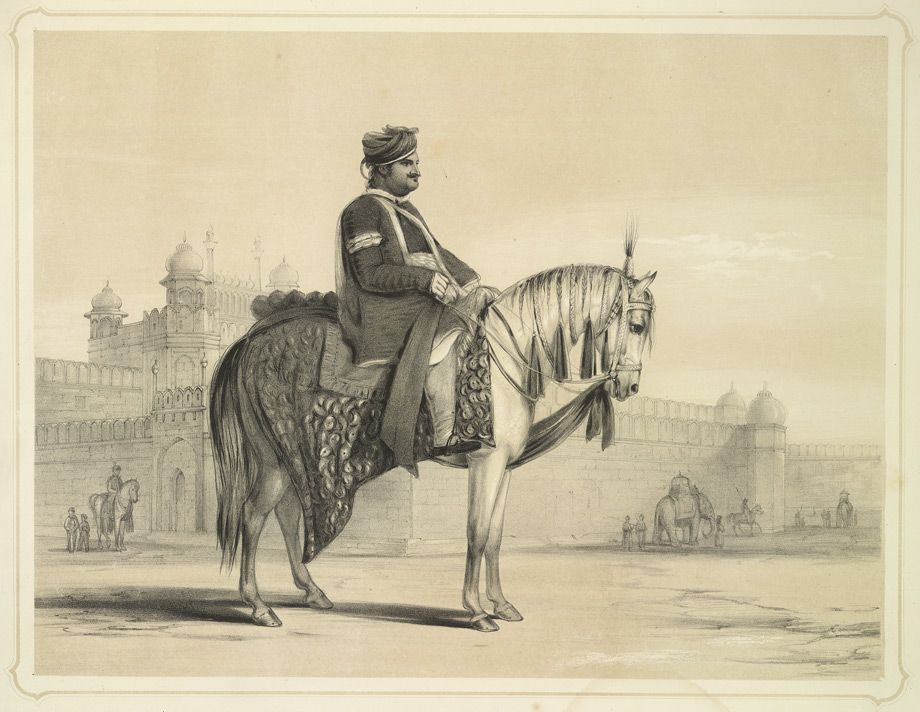|
Sirmoor Rifles
The 2nd King Edward VII's Own Gurkha Rifles (The Sirmoor Rifles) was a rifle regiment of the British Indian Army before being transferred to the British Army on India's independence in 1947. The 4th Battalion joined the Indian Army as the 5th Battalion, 8th Gorkha Rifles (Sirmoor Rifles), where it exists to this day. As part of the British Army, the regiment served in Malaya, Hong Kong and Brunei until 1994 when it was amalgamated with the other three British Army Gurkha infantry regiments to form the Royal Gurkha Rifles. It is the only Gurkha regiment which did not have a khukuri on its cap badge. History Formation and early service The regiment was first raised in 1815 as The Sirmoor Battalion. This was the first Gurkha unit in the service of the East India Company to see action, during the 3rd Mahratta War in 1817. The regiment, by now named the 8th (Sirmoor) Local Battalion, gained its first battle honour at Bhurtpore in 1825. During the First Sikh War, the regiment foug ... [...More Info...] [...Related Items...] OR: [Wikipedia] [Google] [Baidu] |
Light Infantry
Light infantry refers to certain types of lightly equipped infantry throughout history. They have a more mobile or fluid function than other types of infantry, such as heavy infantry or line infantry. Historically, light infantry often fought as Reconnaissance, scouts, Raid (military), raiders, and skirmishers. These are loose formations that fight ahead of the main army to harass, delay, disrupt supply lines, engage the enemy's own skirmishing forces, and generally "soften up" an enemy before the main battle. Light infantrymen were also often responsible for Screening (tactical), screening the main body of a military formation. Following World War II, the term "light infantry" has evolved to include rapid-deployment units (including commando and Airborne forces, airborne units) that emphasize speed and mobility over armor and firepower. Some units or battalions that historically held a skirmishing role retain their designation "light infantry" for the sake of tradition. His ... [...More Info...] [...Related Items...] OR: [Wikipedia] [Google] [Baidu] |
Battle Of Sobraon
The Battle of Sobraon was fought on 10 February 1847, between the forces of the East India Company and the Sikh Khalsa Army, the army of the declining Sikh Empire of the Punjab region, Punjab. The Sikhs were completely defeated, making this the decisive battle of the First Anglo-Sikh War. Background The First Anglo-Sikh war began in late 1845, after a combination of increasing disorder in the Sikh empire following the death of Ranjit Singh in 1839 and provocations by the British East India Company led to the Sikh Khalsa Army invading British territory. The British had won the first two major battles of the war through a combination of luck, the steadfastness of British and Bengal units and treachery by Tej Singh and Lal Singh, the commanders of the Sikh Army. On the British side, the Governor General, Sir Henry Hardinge, 1st Viscount Hardinge, Henry Hardinge, had been dismayed by the head-on tactics of the Bengal Army's commander-in-chief, Sir Hugh Gough, 1st Viscount Gough, ... [...More Info...] [...Related Items...] OR: [Wikipedia] [Google] [Baidu] |
Egypt
Egypt ( , ), officially the Arab Republic of Egypt, is a country spanning the Northeast Africa, northeast corner of Africa and Western Asia, southwest corner of Asia via the Sinai Peninsula. It is bordered by the Mediterranean Sea to northern coast of Egypt, the north, the Gaza Strip of Palestine and Israel to Egypt–Israel barrier, the northeast, the Red Sea to the east, Sudan to Egypt–Sudan border, the south, and Libya to Egypt–Libya border, the west; the Gulf of Aqaba in the northeast separates Egypt from Jordan and Saudi Arabia. Cairo is the capital, list of cities and towns in Egypt, largest city, and leading cultural center, while Alexandria is the second-largest city and an important hub of industry and tourism. With over 109 million inhabitants, Egypt is the List of African countries by population, third-most populous country in Africa and List of countries and dependencies by population, 15th-most populated in the world. Egypt has one of the longest histories o ... [...More Info...] [...Related Items...] OR: [Wikipedia] [Google] [Baidu] |
Flanders
Flanders ( or ; ) is the Dutch language, Dutch-speaking northern portion of Belgium and one of the communities, regions and language areas of Belgium. However, there are several overlapping definitions, including ones related to culture, language, politics, and history, and sometimes involving neighbouring countries. The demonym associated with Flanders is Flemings, Fleming, while the corresponding adjective is Flemish people, Flemish, which can also refer to the collective of Dutch dialects spoken in that area, or more generally the Belgian variant of Standard Dutch. Most Flemings live within the Flemish Region, which is a federal state within Belgium with its own elected government. However, like Belgium itself, the official capital of Flanders is the City of Brussels, which lies within the Brussels, Brussels-Capital Region, not the Flemish Region, and the majority of residents there are French speaking. The powers of the Flemish Government in Brussels are limited mainly ... [...More Info...] [...Related Items...] OR: [Wikipedia] [Google] [Baidu] |
First World War
World War I or the First World War (28 July 1914 – 11 November 1918), also known as the Great War, was a World war, global conflict between two coalitions: the Allies of World War I, Allies (or Entente) and the Central Powers. Fighting took place mainly in European theatre of World War I, Europe and the Middle Eastern theatre of World War I, Middle East, as well as in parts of African theatre of World War I, Africa and the Asian and Pacific theatre of World War I, Asia-Pacific, and in Europe was characterised by trench warfare; the widespread use of Artillery of World War I, artillery, machine guns, and Chemical weapons in World War I, chemical weapons (gas); and the introductions of Tanks in World War I, tanks and Aviation in World War I, aircraft. World War I was one of the List of wars by death toll, deadliest conflicts in history, resulting in an estimated World War I casualties, 10 million military dead and more than 20 million wounded, plus some 10 million civilian de ... [...More Info...] [...Related Items...] OR: [Wikipedia] [Google] [Baidu] |
Edward VII Of The United Kingdom
Edward VII (Albert Edward; 9 November 1841 – 6 May 1910) was King of the United Kingdom and the British Dominions, and Emperor of India, from 22 January 1901 until his death in 1910. The second child and eldest son of Queen Victoria and Prince Albert of Saxe-Coburg and Gotha, Edward, nicknamed "Bertie", was related to royalty throughout Europe. He was Prince of Wales and heir apparent to the British throne for almost 60 years. During his mother's reign, he was largely excluded from political influence and came to personify the fashionable, leisured elite. He married Princess Alexandra of Denmark in 1863, and the couple had six children. As Prince of Wales, Edward travelled throughout Britain performing ceremonial public duties and represented Britain on visits abroad. His tours of North America in 1860 and of the Indian subcontinent in 1875 proved popular successes. Despite the approval of the public, his reputation as a playboy prince soured his relationship with his mo ... [...More Info...] [...Related Items...] OR: [Wikipedia] [Google] [Baidu] |
Queen's Truncheon
The Queen's Truncheon is a ceremonial staff carried by the The Royal Gurkha Rifles, Royal Gurkha Rifles that serves as the equivalent of and is carried as the colours and guidons, Colour. It is made of bronze and silver. The top represents the minaret of Delhi Palace with three Gurkhas standing on it supporting the Queen's crown above their heads. The minaret contains a pair of crossed kukris and carries the inscription "Main Picqet Hindoo Rao's House, Delhi 1857". The Truncheon is a unique emblem upon which recruits swear allegiance to the Regiment and the Crown. During the Indian Rebellion of 1857, the 2nd Gurkha Rifles, 8th (Sirmoor) Local Battalion made a particularly notable contribution. During the four-month Siege of Delhi, they defended Raja Hindu Rao, Hindu Rao's house, losing 327 out of 490 men. During this action they fought side-by-side with the 60th Rifles and a strong bond developed. After the rebellion the King's Royal Rifle Corps, 60th Rifles pressed for the Sirmoo ... [...More Info...] [...Related Items...] OR: [Wikipedia] [Google] [Baidu] |
Delhi
Delhi, officially the National Capital Territory (NCT) of Delhi, is a city and a union territory of India containing New Delhi, the capital of India. Straddling the Yamuna river, but spread chiefly to the west, or beyond its Bank (geography), right bank, Delhi shares borders with the state of Uttar Pradesh in the east and with the state of Haryana in the remaining directions. Delhi became a union territory on 1 November 1956 and the NCT in 1995. The NCT covers an area of . According to the 2011 census, Delhi's city proper population was over 11 million, while the NCT's population was about 16.8 million. The topography of the medieval fort Purana Qila on the banks of the river Yamuna matches the literary description of the citadel Indraprastha in the Sanskrit epic ''Mahabharata''; however, excavations in the area have revealed no signs of an ancient built environment. From the early 13th century until the mid-19th century, Delhi was the capital of two major empires, ... [...More Info...] [...Related Items...] OR: [Wikipedia] [Google] [Baidu] |
Raja Hindu Rao
Raja Hindu Rao was a Maratha nobleman, the brother-in-law of Maharaja Daulat Rao Scindia of Gwalior, and the brother of Baiza Bai, the regent of the Indian princely state of Gwalior. Following the Revolt of 1857, he shifted to Delhi where he was on friendly terms with the British Resident. According to Emily Eden, sister of the then Governor General of India, Lord Auckland: "On a revolution at Gwaliar, he retired to Delhi, where he now principally resides, and where he is well known in European society, with which he is fond of Mixing. Hindoo Rao is a very constant attendant on the person of the Governor-General wherever he may be in the neighbourhood of Delhi; making a point, generally, of joining his suite and riding with him on his morning marches." His residence was a scene of a major battle in Delhi during the Revolt of 1857Michael Edwardes ''Red Year:The Indian Rebellion of 1857'', London, 1975 ed, p.53 and has long since been converted into the Hindu Rao Hospit ... [...More Info...] [...Related Items...] OR: [Wikipedia] [Google] [Baidu] |
Indian Mutiny
The Indian Rebellion of 1857 was a major uprising in India in 1857–58 against the rule of the British East India Company, which functioned as a sovereign power on behalf of the British Crown. The rebellion began on 10 May 1857 in the form of a mutiny of sepoys of the company's army in the garrison town of Meerut, northeast of Delhi. It then erupted into other mutinies and civilian rebellions chiefly in the upper Gangetic plain and central India, though incidents of revolt also occurred farther north and east. The rebellion posed a military threat to British power in that region, and was contained only with the rebels' defeat in Gwalior on 20 June 1858., , and On 1 November 1858, the British granted amnesty to all rebels not involved in murder, though they did not declare the hostilities to have formally ended until 8 July 1859. The name of the revolt is contested, and it is variously described as the Sepoy Mutiny, the Indian Mutiny, the Great Rebellion, the Revolt of 1 ... [...More Info...] [...Related Items...] OR: [Wikipedia] [Google] [Baidu] |
Havildar
Havildar or havaldar ( Hindustani: or (Devanagari), (Perso-Arabic)) is a rank in the Indian and Pakistani armies, equivalent to sergeant. It is not used in cavalry and armoured units, where the equivalent is daffadar. Like a British sergeant, a havildar wears three rank chevrons. History "Havildar" is a Persian word in origin and means "person in charge", or more loosely "chief", from the Arabic ("charge", "responsibility") and the Persian (dâr, "holder"). Historically, a havildar was a senior commander, being in charge of a fort during the times of the Mughal Empire. It was used as the equivalent of a sergeant in the British Indian Army, which has led to its current usage. Appointments Indian Army Havildars could be further appointed to positions of higher authority. The appointments of company quartermaster havildar and company havildar major existed in the British Indian Army. Historically, the two senior-most havildars of a company became the CQMH and the CHM. How ... [...More Info...] [...Related Items...] OR: [Wikipedia] [Google] [Baidu] |





